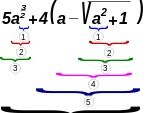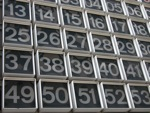 If you've ever practiced determining the day of the week for any date in your head, especially if you've used one of my methods such as the version I teach in the Mental Gym or Day One, you've probably run into the fact that these methods really only work back to seemingly random dates, such as Sept. 14, 1752 or Oct. 15, 1582.
If you've ever practiced determining the day of the week for any date in your head, especially if you've used one of my methods such as the version I teach in the Mental Gym or Day One, you've probably run into the fact that these methods really only work back to seemingly random dates, such as Sept. 14, 1752 or Oct. 15, 1582.
This is due to the switch from the Julian calendar to the Gregorian calendar, as well as the fact that the calendar calculation formulas are designed only to work with the latter. What if you'd like to calculate dates in the Julian calendar?
In today's post, you'll learn how to handle Julian dates all the way back to the 200s!
The first official switch from the Julian to the Gregorian calendar happened in 1582, as noted in the video below. October 4, 1582 was not followed by October 5, but by October 15, 1582, effectively skipping 10 days.
Great Britain made the switch to the Gregorian calendar by jumping from Sept. 2, 1752 to Sept. 14, 1752, effectively skipping 11 days. Since Great Britain and its colonies were the majority of the English-speaking world at the time, native English speakers use this date for the conversion. Here are the years various countries made the switch, and here are the specific switching dates by country.
Since the switch was made due to the inaccuracy of the Julian calendar, the question becomes one of how to compensate for the change? As mentioned above, the change in the 1500s was only 10 days, yet in the 1700s it was an 11-day change.
To start, take the given year, and drop the last (rightmost) 2 digits. For example, 1491 becomes 14, an 943 becomes 9. This century number, which we'll call x, can be used to find the number of days that need to be added to the Julian date, in order to get the corresponding Gregorian date.
UPDATE (June 3, 2013): I've run across a much easier formula for determining the days needed to go from the Julian to the Gregorian calendar. I'll post the updated method here, and keep the method from the original post below the line.
Once you've got the century digits as x, multiply it by 3. If 3x isn't already a multiple of 4, round it up to the next multiple of 4. Once you've done that, divide the number by 4, subtract 2, and you've got your answer!
For example, let's find the adjustment needed for the 1200s. In this case x = 12, and 12 × 3 = 36. 36 is already a multiple of 4, so there's no adjustment at this point. Finally, we divide by 4 and then subtract 2, so 36 ÷ 4 = 9, and 9 - 2 = 7. This means we add 7 days to Julian dates in the 1200s to get the corresponding Gregorian dates.
What about the 900s? 9 × 3 = 27, which isn't evenly divisible by 4, so we round it up to the next multiple of 4, which is 28. 28 ÷ 4 = 7, and 7 - 2 = 5, so we would add 5 days to any Julian date in the 900s to get the corrresponding Gregorian date.
Naturally, once you have the correct Gregorian date, you can use standard calendar formulas to get the day of the week for the given date.
Since I posted this on May 30, 2013, let's try the Julian date of May 30, 1013. What would the corresponding date be in the Gregorian calendar? 10 × 3 = 30, and we round 30 up to the next multiple of 4, which is 32. 32 ÷ 4 = 8, and 8 - 2 = 6. Now we add 6 days to May 30 to get May 36, or more accurately, June 5th (36 - 31 days in May = 5). If we double check with Wolfram|Alpha, we see that May 30th, 1013 in the Julian calendar is indeed June 5th, 1013 in the Gregorian calendar.
Once you have a Gregorian date, you can treat it as you would any other date in your system. With practice, you can now go back as far as the 200s, since the adjustment for the 200s is 0. You can actually go farther back, but the calculations have additional things you have to deal with, such as negative adjustments, and compensation for date with BC or BCE before them.
In performance, and with a little practice, you can buy yourself the extra time needed for this extra calculation by performing the calculation while explaining briefly about the Julian and Gregorian calendars. Practice with Julian dates, and you'll surprise yourself with a wider range on your calendar calculation abilities!
------
ORINGAL POST:
It's done with the following formula:
Those funny-looking brackets with an upside-down L-shape simply mean to round any fractional answer you get upwards. Mathematicians and programmers know this as the ceiling function.
As a simple first example, let's assume we're working with a date in the 1200s. For any such date, we drop the last 2 digits, leaving us with x = 12. First, subtract x from 16: 16 - 12 = 4. Next, divide that result by 4: 4 ÷ 4 = 1. Finally add that result to x again, and subtract 6: 1 + 12 - 6 = 13 - 6 = 7.
That result of 7 means that, for any date in the 1200s, we would need to add 7 days to the Julian calendar to get the corresponding Gregorian date. October 10, 1252 in the Julian calendar becomes October 17, 1252 in the Gregorian calendar.
Naturally, once you have the correct Gregorian date, you can use standard calendar formulas to get the day of the week for the given date.
That 1200s example worked out nicely because 4 divided by 4 comes out even. What about when we're dealing with a century that doesn't work out so neatly? Let's try a date in the 900s.
For the 900s, of course, x = 9, so let's start going through the formula again. The first step is 16 - 9 = 7. Next, we have to work out 7 ÷ 4. The exact mathematical answer is 1.75, but since the next step is to round up any fractional answers (remember the upside-down L-shaped brackets?) up, all you really need to know is that 7 ÷ 4 = “1 and some extra”. When you round this up, you get 2.
Now, you can work through the rest of the formula just as before: 2 + 9 - 6 = 11 - 6 = 5. So, for any date in the 900s, you would need to add 5 days to find the corresponding Gregorian date. For the 800s to the 1700s, here's the adjustment required for each century.
Since I posted this on May 30, 2013, let's try the Julian date of May 30, 1013. What would the corresponding date be in the Gregorian calendar? We know x = 10, so 16 - 10 = 6. Next, 6 ÷ 4 = 1 and some more, which rounds up to 2. 2 + 10 - 6 = 12 - 6 = 6, so we need to add 6 days to get the Gregorian date. May 30th + 6 days = May 36, or more accurately, June 5th.










